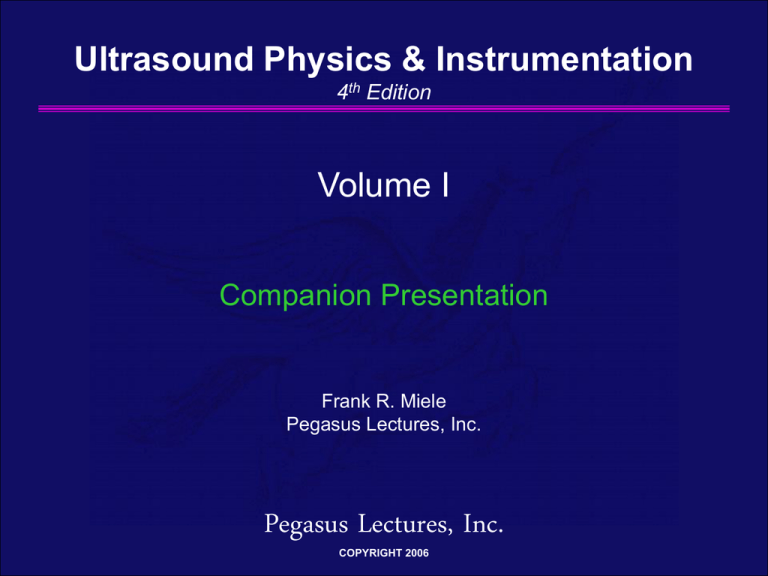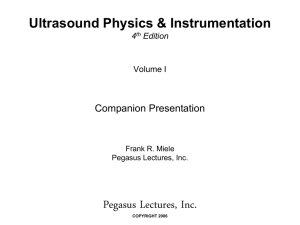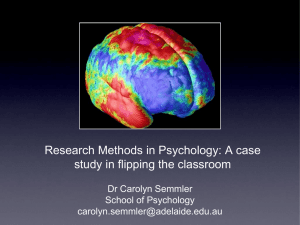Chapter6_level_1
advertisement

Ultrasound Physics & Instrumentation 4th Edition Volume I Companion Presentation Frank R. Miele Pegasus Lectures, Inc. Pegasus Lectures, Inc. COPYRIGHT 2006 License Agreement This presentation is the sole property of Pegasus Lectures, Inc. No part of this presentation may be copied or used for any purpose other than as part of the partnership program as described in the license agreement. Materials within this presentation may not be used in any part or form outside of the partnership program. Failure to follow the license agreement is a violation of Federal Copyright Law. All Copyright Laws Apply. Pegasus Lectures, Inc. COPYRIGHT 2006 Volume I Outline Chapter 1: Mathematics Chapter 2: Waves Chapter 3: Attenuation Chapter 4: Pulsed Wave Chapter 5: Transducers Chapter 6: System Operation Level 1 Level 2 Pegasus Lectures, Inc. COPYRIGHT 2006 Chapter 6: System Operation - Level 1 System operation deals with both the processing of the returning echoes and the system controls. Level 1 focuses on: general signal processing of the received radio frequency (RF) echoes the basic controls of receiver gain time gain compensation the concept of signal to noise ratio (SNR). Level 2 focuses on overall system design, more in depth discussion about compensation, scan conversion, compression, measurements, and display. Pegasus Lectures, Inc. COPYRIGHT 2006 System Major Subsystems There are many functions that an ultrasound system performs. The system is commonly subdivided into two major sub-systems: The Front End (often referred to as the receiver) The Back End (often referred to as the scan converter In reality, there are many ways in which the system functions could be partitioned including separating out the display monitor and the data storage systems. Pegasus Lectures, Inc. COPYRIGHT 2006 Basic Processes of Real-Time Imaging There are six core functions that an ultrasound system must perform: Transmit beams (Front end) Receive beams (Front end) Process the returned data (Front end and Back end) Perform measurements in the processed data (Back end) Display the processed data (Back end) Store the processed data (Back end) Pegasus Lectures, Inc. COPYRIGHT 2006 Basic System Functions Fig. 6: (Pg 308) Pegasus Lectures, Inc. COPYRIGHT 2006 Transmitter (Pulser) In Chapter 4 we learned about pulsed wave. In Chapter 5 we learned about steering and focusing by phasing, and sequencing. The transmit beamformer is responsible for creating all of the timing, phase delays, and transmit signals which create each individual beam and, over time, a scan. Pegasus Lectures, Inc. COPYRIGHT 2006 The “Receiver” The receiver of the front end of the ultrasound system performs many functions such as: Amplification Compensation Compression Demodulation Rejection (The above functions are the five functions that are generally included on the credentialing exams. In reality there are many major functions not included in this list.) Pegasus Lectures, Inc. COPYRIGHT 2006 The Receiver In reality there are many more functions performed by the receivers such as: A/D conversion beamforming (phasing and adding together each channel signal) frequency filtering parallel processing and many more Pegasus Lectures, Inc. COPYRIGHT 2006 The Concept of Signal to Noise Ratio One of the most important concepts to learn is the concept of signal to noise ratio (SNR). The signal to noise ratio is a measure of how strong a signal is relative to the background noise, or: the ratio of the signal amplitude to the noise amplitude. Note that a large signal does not guarantee a high quality image, since even a large signal could be masked by noise. In essence poor SNR can result from a low amplitude signal, a high noise level, or both. Pegasus Lectures, Inc. COPYRIGHT 2006 The Concept of Apparent SNR A distinction should be made between true SNR and apparent SNR. If the system settings are set inappropriately, the SNR may appear to be poor, even when the true SNR is relatively good. Pegasus Lectures, Inc. COPYRIGHT 2006 Signal to Noise Ratio Notice that in two of the three cases, the SNR is poor. In the middle picture, the SNR is low because of high amplitude noise. In the picture on the right, the SNR is poor because the signal has a low amplitude. Fig. 1: (Pg 304) Pegasus Lectures, Inc. COPYRIGHT 2006 Apparent SNR Although the SNR is the same in both of these cases, the first case results in poor apparent SNR, whereas the second case appears as good SNR. Fig. 2: (Pg 305) Pegasus Lectures, Inc. COPYRIGHT 2006 Varying Receive Gain & Apparent SNR Both of the images were produced using the same transmit power but different receive gain. The lower gain of Figure 3a results in poor apparent SNR, whereas the higher receive gain of 3b appears as good SNR. Fig. 3a: Signal Appears Weak Fig. 3b: Signal Appears Strong Fig. 3: (Pg 305) Pegasus Lectures, Inc. COPYRIGHT 2006 Varying Transmit Power & SNR Figure 4a has poor SNR because of low transmit power. Figure 4b shows good SNR as a result of higher transmit power. Both images used the same receive gain. Fig. 4a: Poor SNR (Weak Signal) Fig. 4b: Good SNR Fig. 4: (Pg 306) Pegasus Lectures, Inc. COPYRIGHT 2006 Too Much Transmit vs. Too Much Gain Notice that Figure 5a appears bright but has good SNR as a result of high transmit power. Figure 5b, appears too bright but has poor SNR as a result of lower transmit and excessive receive gain. Fig. 5a: Transmit too High but Good Fig. 5b: Receive Gain too High, SNR SNR Good but Apparent SNR Worse Fig. 5: (Pg 305) Pegasus Lectures, Inc. COPYRIGHT 2006 SNR (from Animation CD) 307 A: Poor SNR 307 D: Poor Apparent SNR 307 B: Good SNR 307 E: Good SNR (Pg 307) Pegasus Lectures, Inc. COPYRIGHT 2006 307 C: Poor Apparent SNR 307 F: Poor Apparent SNR Improving SNR There are many ways of improving the signal strength. Increase transmit power Use a lower frequency transducer (for deeper imaging depths) Use a different imaging plane Maneuvers to remove attenuators such as lung and gas Move transmit focus deeper Use a larger aperture transducer (allows for deeper focus) Use semi-invasive techniques (“endo-probes” and transesophageal) Note that increasing the receiver gain does not improve the SNR – it increases both the signal and the noise proportionally. Pegasus Lectures, Inc. COPYRIGHT 2006 Raw RF Signal The returning RF signals are changed (modulated) by the mechanical interaction of the wave with the body. Larger acoustic impedance mismatches result in higher amplitude signals. Signals from deeper depths (later in time) are also attenuated more than reflections from shallower depths (earlier in time). Fig. 7: (Pg 311) Pegasus Lectures, Inc. COPYRIGHT 2006 Amplified Raw RF Signal Amplification is the process of multiplying the received signal to make the signal larger. Amplification results in an increase of the amplitude for signals from all depths uniformly. Fig. 8: (Pg 311) Pegasus Lectures, Inc. COPYRIGHT 2006 Amplification Visualized Amplitude Amplitude The image on the left provides a reference for the amplified image on the right. Time Time Raw RF Signal Amplified Raw RF Signal Pegasus Lectures, Inc. COPYRIGHT 2006 Varying Receive Gain (Amplification) 9a: Severely Undergained 9d: Appropriately Gained Fig. 9: (Pg 312) 9b: Badly Undergained 9e: Optimally Gained Pegasus Lectures, Inc. COPYRIGHT 2006 9c: Undergained 9f: Slightly Overgained Amplification (Animation) (Pg 312) Pegasus Lectures, Inc. COPYRIGHT 2006 Compensated RF Signal More amplification is required for signals from deeper depths to compensate for the increased attenuation. Notice in the image below that the signals later in time are amplified more than the signals earlier in time (compare with image of Figure 8). Fig. 10: (Pg 313) Pegasus Lectures, Inc. COPYRIGHT 2006 Compensation Visualized Amplitude Amplitude The image on the left provides a reference for the compensated image on the right. Time Compensated RF Signal Amplified Raw RF Signal Compensation is performed by the system TGCs. Pegasus Lectures, Inc. COPYRIGHT 2006 Time Receive Gain and TGC Fig. 11: (Pg 314) Fig. 12: (Pg 314) Pegasus Lectures, Inc. COPYRIGHT 2006 Incorrect TGC Settings Inappropriate TGC settings can result in regions appearing too light or too dark as seen in the two images below. Fig. 13a: (Mid-range TGCs Too Low) Fig. 13b: (Mid-range TGCs Too High) Fig. 13: (Pg 314) Pegasus Lectures, Inc. COPYRIGHT 2006 Simple Compression Map Compression is a method to reduce the dynamic range by mapping a larger range of signals into a smaller range of signals. The following simplistic map shows a 5 to 1 reduction in signal dynamic range. Fig. 14: (Pg 315) Pegasus Lectures, Inc. COPYRIGHT 2006 Log Compressed RF Signal Compression is needed since the dynamic range of the returning echoes is much greater than the dynamic range visible to the human eye. Through compression, the ratio of the maximum to the minimum signal is significantly reduced. Fig. 15: (Pg 316) Pegasus Lectures, Inc. COPYRIGHT 2006 Compression Visualized Amplitude Amplitude The image on the left provides a reference for the amplified image on the right. Time Log Compressed RF Signal Compensated RF Signal Time Compression in the receiver is not under user control. However there is more signal compression which takes place in the back end of the system that is under user control. Pegasus Lectures, Inc. COPYRIGHT 2006 Various Compression Maps 16a:Most Contrast 16d (Pg 317) 16b 16c 16e 16f: Least Contrast Pegasus Lectures, Inc. COPYRIGHT 2006 Compression (Animation) (Pg 317) Pegasus Lectures, Inc. COPYRIGHT 2006 Rectification of RF Signal The process of signal detection (demodulation) is actually comprised of two, more fundamental steps: rectification and envelope detection. The following image demonstrates the process of rectification, converting the signal from being bi-polar to uni-polar. Fig. 17: (Pg 318) Pegasus Lectures, Inc. COPYRIGHT 2006 Envelope Detection of RF Signal The second stage of signal detection is envelope detection. The output of this stage is basically the early form of ultrasound referred to as amplitude mode (Amode). Notice how the height of the amplitude corresponds to the amplitude of the signal. Fig. 18: (Pg 319) Pegasus Lectures, Inc. COPYRIGHT 2006 Demodulated Signal (A-mode) In A-mode, the horizontal axis corresponds to time (which is related to depth) and the vertical axis corresponds to the signal strength (amplitude). Fig. 19: (Pg 319) Pegasus Lectures, Inc. COPYRIGHT 2006 Demodulation Visualized Amplitude Amplitude The image on the left provides a reference for the demodulated image on the right. Log Compressed RF Signal Time Demodulated Signal (A-Mode) Pegasus Lectures, Inc. COPYRIGHT 2006 Time Demodulated Signal after Rejection The premise of rejection is that signals below a “threshold” are eliminated as too weak to be of value. The reality is that “rejection” is more a natural limit that results from noise in the image. Signals below the noise floor are masked by the noise in the image. Fig. 20: (Pg 320) Pegasus Lectures, Inc. COPYRIGHT 2006 Rejection Visualized Amplitude Amplitude The image on the left provides a reference for the application of rejection to the image on the right. Demodulated Signal (A-Mode) Time Demodulated Signal After Rejection Time Pegasus Lectures, Inc. COPYRIGHT 2006 A-mode from a Radial Artery Fig. 21: (Pg 321) Pegasus Lectures, Inc. COPYRIGHT 2006 Add Title Blank Slide: This blank slide is here to help facilitate adding new content. If you would like to add material to this presentation, copy this slide and place in the correct location. Pegasus Lectures, Inc. COPYRIGHT 2006







